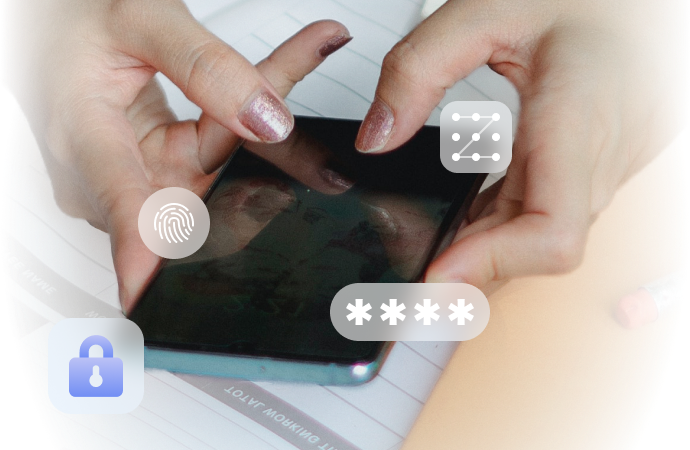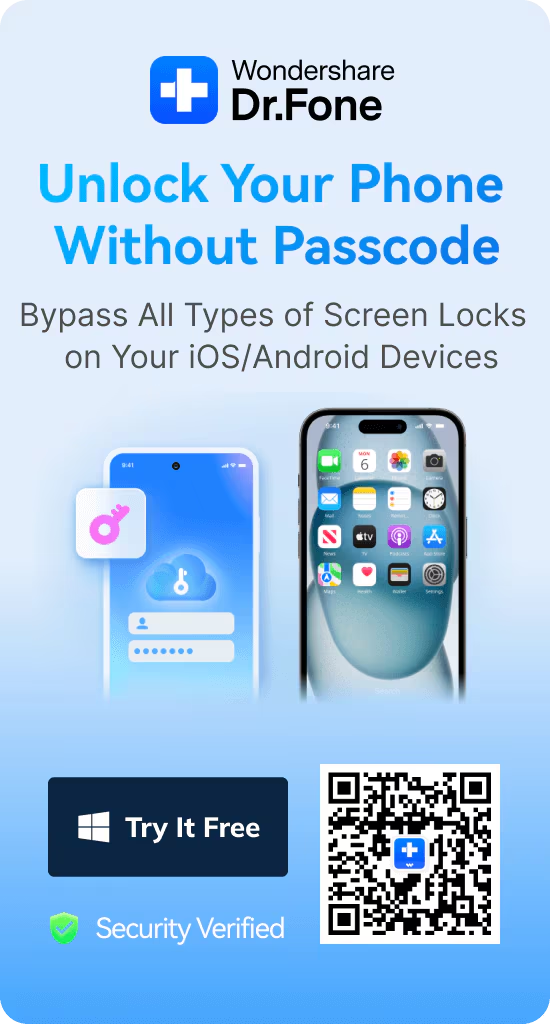
A Step-by-Step Tutorial on Android Lock Screen Settings
Aug 27, 2025 • Filed to: Screen Lock Removal • Proven solutions
The lock screen is the first thing you see when unlocking your phone, and it offers plenty of opportunities to enhance security. Multiple ways are available for you to customize and enhance these safety options on your smartphone. With Android offering a variety of lock screen options, there’s no shortage of ways to secure your device.
These range from fingerprint scans to facial recognition and PIN codes, depending on your preferences. This comprehensive guide will explore all available Android lock screen settings and how to use them. Follow along to find the best ways to get your mobile secure from external factors.

- Part 1. What Are Android Lock Screen Settings on Your Android Smartphone?
- Part 2. How to Enable Lock Screen on Your Android
- Part 3. How to Put Face ID on Your Android to Unlock Screen
- Part 4. How to Lock Apps in Android via Secure Folder
- Part 5. How to Set Up Parental Controls on Android
- Pro Tip. How to Unlock Your Android Smartphone Without Passcode/Face ID/Touch ID
Part 1. What Are Android Lock Screen Settings on Your Android Smartphone?
Protecting the content stored within your mobile is paramount for almost every user. When securing your Android smartphone, the lock screen is your first line of defense. These settings range from the parental lock on Android to fingerprint scans or facial recognition.
1. Screen Lock Types
As mentioned before, you have many choices when it comes to selecting this first line of defense. The screen lock type you choose is one of your most important decisions. Each offers varying levels of protection, allowing you to pick one that suits your needs. The possible screen lock options include:
- Pattern Lock: This method involves drawing a unique pattern on a grid of dots. While convenient, it may not be as secure as other options if the one you opted for is simple.
- PIN Code: It requires you to enter a numeric code to unlock your phone. While simple to set up and easy to remember, the longer PINs provide more security.
- Password: As a more complex option, it lets you combine letters, numbers, and symbols. This provides a higher level of security compared to a PIN or pattern.
- Fingerprint Scan: With this lock, you can use your fingerprint to unlock your device quickly. It’s secure and convenient but requires a phone with a compatible fingerprint sensor.
- Facial Recognition: The latest in this list, it uses facial features to unlock your phone. Though convenient, it may not be available on all Android devices.
2. Extend Unlock
While securing your phone is vital, having to bypass the lock again and again can become annoying. That's where the Extend Unlock feature on Android devices comes into the fray. It lets you bypass the lock screen when you are in a designated trusted environment.
While this function can save time, it’s important to consider the security implications. Using it without proper backup options might make it easier for someone else to access your phone.
3. Secure Lock Settings
You can further customize the screen lock configurations to make them more robust or suit your preferences. These settings are designed to enhance the protection of your device via different options. The several choices offered by Android include:
- Lock Screen Timeout: It determines how long your phone remains unlocked after you’ve interacted with it.
- Require Unlock: This function lets you configure the automatic lock conditions for your device.
- Making Pattern Visible: While Android hides the pattern you draw on the lock screen, you can opt to make it visible for convenience.
- Network Settings Access: You can choose to restrict modifying Wi-Fi and mobile data options on a locked phone to avoid security risks.
4. Always On Display
This feature is a convenience that keeps key information visible on your screen when the phone is locked. It can be helpful to quickly view notifications, time, or battery status without unlocking your device. Yet, it can pose potential security risks depending on what information is displayed.

By default, the Always On Display shows the time, date, and notification icons. However, certain apps might allow you to show more detailed information, like message previews.
5. Other Features
Beyond the standard lock screen settings, Android also offers many extra options that can enhance security. These features are designed to give you more control over your phone's access and ensure that only authorized users can unlock it. Some other important security-related choices include:
- Smart Lock: It allows your phone to stay unlocked in trusted environments, like a connection to a trusted Bluetooth device. As smart lock settings reduce the level of security when in trusted situations, it’s important to use them carefully.
- Factory Reset Protection: FRP is a built-in security feature that prevents anyone from using your phone after a hard reset. It requires your Google account details before granting device access.
- Device Finders and Tracking: Features like Find My Device let you remotely locate, lock, or erase your device if it is lost or stolen. When enabled, these give you a way to protect your content and even a chance to wipe your phone.
- App Lock: This feature lets you add extra layers of security to individual apps on your device using the same screen lock or a new one.
- Parental Controls: When sharing your device with children, this feature lets you manage screen time to block inappropriate content and limit app downloads.
Part 2. How to Enable Lock Screen on Your Android
Moving forward, you should secure your mobile with this robust screen lock so you can protect your personal information. Doing so lets you prevent unauthorized access to your device and ensure your data remains private. After setting it up, you can change lock screen wallpapers to enhance mobile aesthetics. Follow these steps to learn how to put passwords on your Android phone:
Step 1. Make your way to your mobile settings and access the “Lock Screen” or “Lock Screen and AOD” tab. Here, opt for the “Lock Screen Type” option and choose the type of security you want to put in place.

Step 2. After making the choice, enter the required details for the selected locked type two times. Finally, hit the “Done” button to complete the process and set up a screen lock for your phone.

Part 3. How to Put Face ID on Your Android to Unlock Screen
Entering long passwords or drawing complex patterns can become annoying whenever you need to access your phone. That’s where facial recognition on your Android device provides a convenient way to unlock it. This biometric feature lets you access your device with just a glance, enhancing user experience. Employ these instructions to learn how to lock an app on Android along with the whole device:
Step 1. Once you have the Settings app launched on your mobile, approach the “Security and Privacy” section. Within this tab, opt for the “Biometrics” option and choose “Face recognition” on the next screen.

Step 2. Here, enter your general screen lock or set it up if you haven’t already, and tap “Continue.” Now, follow the instructions carefully to register your face for the security feature.

Part 4. How to Lock Apps in Android via Secure Folder
From banking to personal shopping, everything nowadays can be done directly on your mobile. This convenience has also increased the importance of further protecting your sensitive information. One way to do so is to lock such apps using a PIN or fingerprint. Utilize the following guide to discover how to lock apps in Samsung via its Secure Folder feature:
Step 1. Access the “Security and Privacy” located in your phone settings and opt for the “More Security Settings” option. Here, tap “Secure Folder” and hit “Continue” on the next screen to follow the instructions to set this folder up.

Step 2. Once you are done, press “Next” to finalize the process and proceed to launch it on the phone. Here, use the “+” icon to select the targeted apps and tap “Add” to lock them via the Secure Folder.

Part 5. How to Set Up Parental Controls on Android
When you share your phone with someone else or your children have access to it, you need better security options. Implementing parental controls is the way to go in such situations. Android offers robust tools to help you monitor and control your children's device usage effectively. You can utilize these steps to learn how to put a parental lock on Android devices:
Step 1. To begin, launch the Settings app on your smartphone and scroll down to opt for the “Digital Wellbeing and Parental Controls” option. You will now get access to a well-drafted dashboard, where you need to tap “Parental Controls” after locating it.

Step 2. Doing so will grant you access to the Google Family Link, which you can set up following the provided instructions. Afterward, answer the related questions, provide account details of the targeted child, and set up the usage of apps like YouTube.

Step 3. Once you have provided all the required details, you will be able to successfully set up a parental lock on Google. You can use the “Stop supervision” option and remove the account to stop these controls at any time.

Pro Tip. How to Unlock Your Android Smartphone Without Passcode/Face ID/Touch ID
One downside of setting up a screen lock is losing phone access when you forget it or it doesn't work. In such situations, a reliable unlocking solution becomes essential. Luckily, Dr.Fone - Screen Unlock (Android) offers a hassle-free way to regain access to your device without any prerequisites. It gets rid of the security lock quickly and securely in all possible scenarios.
This professional tool is designed to circumvent various screen lock types, including both basic and biometric security measures. It lets you regain access in just a few clicks, making it an ideal choice for both tech-savvy users and beginners. Moreover, you get support for a wide range of Android devices to ensure useful alternatives to lock screen widgets on brands like Samsung, LG, Huawei, etc.
Advantages Associated with Employing Dr.Fone - Screen Unlock (Android)
- Offers a mode to unlock certain Samsung and LG devices without erasing personal data, preserving essential files.
- Helps bypass Google’s Factory Reset Protection (FRP) on Android devices, allowing access after a reset.
- Unlocks devices within minutes, eliminating the need for manual solutions or professional assistance.

Dr.Fone - Screen Unlock (Android)
Bypass Samsung Phone's Lock Screen Without Data Loss
- Unlock your Lenovo tablet quickly and securely
- Easily remove passwords and screen locks of all types
- Enjoy a streamlined experience with no technical background required
- Feel confident with solutions backed by a high success rate
Quick Manual to Unlock Your Android Smartphone Without Passcode/Face ID/Touch ID
The program ensures a safe process to restore mobile access with minimal risk of damaging your device or causing other issues. Detailed below are the instructions needed to unlock an Android after forgetting its passcode:
Step 1. Move to the Screen Unlock Menu to Commence the Task
To begin, open Dr.Fone on your computer and go to the “Toolbox” section to access multiple utilities. Then, move forward by selecting the “Screen Unlock” option and choosing “Android” as the device category when prompted. Once done, click “Unlock Android Screen” and connect your Android phone to the system securely.

Step 2. Activate the Required Mode Following the Software’s Guide
At this point, pick your device brand and wait as the tool prompts you to put the phone into the necessary mode, such as Download Mode. When you are unsure about the procedure, follow the on-screen guidelines to ensure proper activation.

Step 3. Finalize the Process of Unlocking Your Android
Once the required mode is activated, the software will begin removing the screen lock automatically. In just a few moments, access to your phone will be restored without any system complications. After completion, simply press “Done” to wrap up the process successfully.

How To Unlock Android Lock Screen?
Conclusion
In summary, the Android lock screen settings are essential for protecting your personal data. It offers various features to enhance security, from setting up a secure lock to using parental controls. However, Dr.Fone - Screen Unlock (Android) provides a quick and reliable solution if you ever find yourself unable to access your phone.
With its ability to bypass multiple lock types without hassle, it ensures you regain access effortlessly. For a safe and efficient way to unlock your device, this robust Android screen unlocker is highly recommended.
Android Unlock
- Android Password Lock
- 1. Reset Lock Screen Password
- 2. Ways to Unlock Android Phone
- 3. Unlock Wi-Fi Networks
- 4. Reset Gmail Password on Android
- 5. Unlock Android Phone Password
- 6. Unlock Android Without Password
- 7. Emergency Call Bypass
- 8. Enable USB Debugging
- 9. Unlock Asus Phone
- 10. Unlock Asus Bootloader
- Android Pattern Lock
- Android Pin/Fingerprint Lock
- 1. Unlock Android Fingerprint Lock
- 2. Recover a Locked Device
- 3. Remove Screen Lock PIN
- 4. Enable or Disable Screen Lock PIN
- 5. Pixel 7 Fingerprint Not Working
- Android Screen Lock
- 1. Android Lock Screen Wallpapers
- 2. Lock Screen Settings
- 3. Customize Lock Screen Widgets
- 4. Apps to Reinvent Your Android
- 5. Lock Screen Wallpaper on Android
- 6. Unlock Android with Broken Screen
- 7. Unlock Google Find My Device Without Problems
- 8. Forgot Voicemail Password on Android
- 9. Unlock SafeSearch on Google
- Android Screen Unlock
- 1. Android Device Manager Unlock
- 2. Unlocking Android Phone Screen
- 3. Bypass Android Face Lock
- 4. Bypass Android Lock Screen
- 5. Bypass Lock Screen By Emergency Call
- 6. Remove Synced Google Account
- 7. Unlock Android without Data Loss
- 8. Unlock Phone without Google Account
- 9. Unlock Android phone
- 10. Reset a Locked Android Phone
- 11. Unlock Doogee Phones
- 12. Best 10 Unlock Apps For Android
- 13. Remove Gmail Account
- 14. Unlock 30/30 Attempts Remaining
- 15. OEM Unlock Missing
- 16. Change Lock Screen Clock
- 17. OEM Unlocking on Android
- 18.Bypass Knox Enrollment Service
- 19. Unlock Google Pixel 6a, 6 or 7
- 20. Best Alternative to MCT Bypass Tool
- 21. Best Way to Unlock Your ZTE Phone
- Android SIM Unlock
- 1. Easily Unlock Android SIM
- 2. 5 Android Unlock Software
- 3. Carrier Unlock Phone to Use SIM
- 4. Change Android Imei without Root
- 5. How to Change SIM PIN on Android
- 6. Best Unlocked Android Phones
- Android Unlock Code
- 1. Lock Apps to Protect Information
- 2. Unlock Secret Features on Phone
- 3. Android SIM Unlock Code Generator
- 4. Ways to Sim Unlock Phone
- 5. Remove Sim Lock without Code
- 6. Updated Android Factory Reset Code
- Google FRP Bypass
- 1. Bypass Google Account Verification
- 2. Bypass Google FRP Lock On Phones
- 3. Bypass Google Pixel FRP
- 4. Huawei Bypass FRP Tools for PC
- 5. Bypass Samsung S22 Ultra FRP
- 6. Bypass Samsung S24 FRP Lock
- 7. EDL Cable Unlock FRP
- 8. Unlock OnePlus Nord FRP
- 9. OnePlus Nord N100 FRP
- 10. EFRP ME APK FRP Bypass
- 11. RootJunky FRP Bypass
- 12. What to Do When Locked Out of Google Account
- 13. Android Utility Tool
- 14. Remove Google FRP Using Online Tools
- Unlock Bricked Phone
- 1. Restore Bricked Mobile Phone
- 2. Fix Motorola Bricked Phone
- 3. Fix Bricked Redmi Note
- 4. Unbrick Oneplus Easily
- 5. Unbrick Xiaomi Phone
- 6. Unbrick Huawei Phone
- 7. Unbrick Poco X3
- 8. Software to Unbrick Samsung
- 9. Unbrick 3DS
- 10. Unbrick PSP
- Android Unlock Tools
- 1. Griffin Unlocker Tool Review
- 2. BMB Unlock Tool Review
- 3. Android Multi Tools Review
- 4. Best Bootloader Unlock APKs
- 5. Top 5 Micromax FRP Tools
- 6. Pangu FRP Bypass
- 7. Google Account Manager APK FRP Review
- 8. D&G Password Unlocker Review
- 9. Android Multi Tools Review
- 10. Easy Samsung FRP Tool Review
- 11.Samfw FRP Tool
- Android MDM
- ● Manage/transfer/recover data
- ● Unlock screen/activate/FRP lock
- ● Fix most iOS and Android issues
- Unlock Now Unlock Now Unlock Now



















Alice MJ
staff Editor